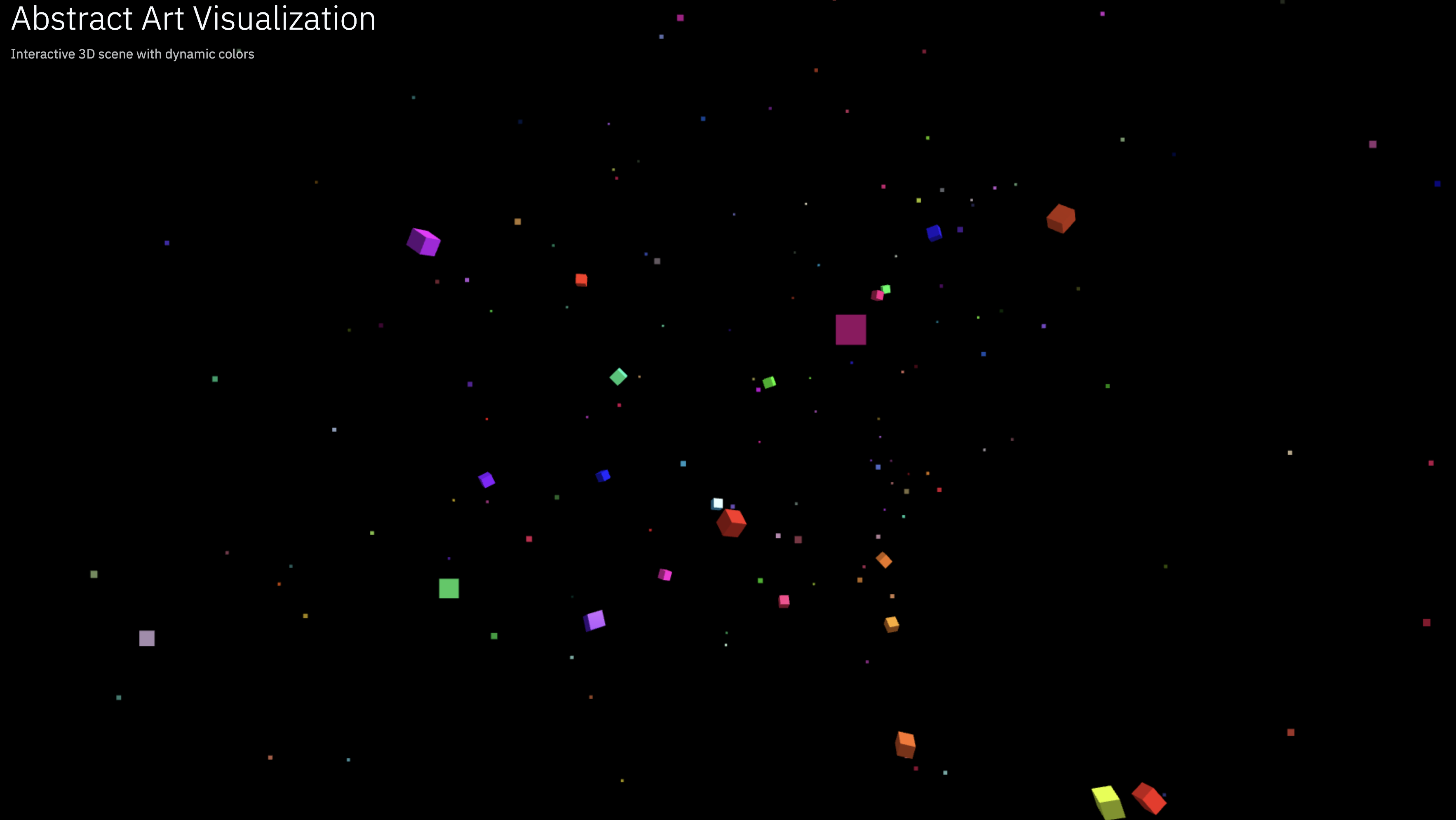
Beyond the Grid: Building Dynamic Experiences with p5.js and Three.js
Beyond the Grid
The standard web has become a grid of predictable boxes. As builders, we should see the web not as a static document, but as a dynamic canvas. Libraries like p5.js and Three.js are the tools we can use to break free from the grid and create immersive, generative experiences. Let's explore how.
p5.js: Your Generative Canvas
p5.js is a JavaScript library that simplifies the process of creating interactive graphics and generative art. It gives you direct control over the HTML canvas, making it a powerful tool for data visualization and unique user interfaces.
The online editor is the perfect place to start experimenting: https://editor.p5js.org/

This isn't just a code sample; it's a blueprint for a generative system. Take it apart and see how it works:
function setup() {
createCanvas(600, 600);
//noFill(0);
angleMode(DEGREES);
rectMode(CENTER);
frameRate(4);
//noLoop(); //before turning this off, try turning off lines 23 & or 26
//the choice of colors were inspired by the risograph
}
function draw()
background(0, 1);
for (let x = 0; x < 12; x++) {
for (let y = 0; y < 12; y++) {
push();
translate(25 + x * 50, 25 + y * 50);
let b = int(random(3));
if (b == 0){
blendMode(OVERLAY);
}
if (b == 1){
blendMode(MULTIPLY);
}
if (b == 1){
blendMode(EXCLUSION);
}
let r = int(random(4));
if (r == 0){
rotate(45);
}
if (r == 1){
rotate(-45);
}
if (r == 2){
rotate(90);
}
if (r == 3){
rotate(180);
}
let d = int(random(4));
if (d == 0){
d = 40;
}
if (d == 1){
d = 40;
}
if (d == 2){
d = 60;
}
if (d == 3){
d = 80;
}
let c = int(random(3));
if (c == 0){
fill(255, 255, 0, 120);
}
if (c == 1){
fill(255, 0, 255, 120);
}
if (c == 2){
fill(0, 255, 255, 120);
}
let s = int(random(12));
if (s == 0){
rect(0, 0, d, d, d/4); //replace argument 3 with 100 for a more interesting look
}
if (s == 1){
rect(0, 0, d, d, d/4); //replace argument 3 with 80 for a cleaner look
}
if (s == 2){
rect(0, 0, d, d, d/4); //replace argument 3 with 60 for a cleaner look
}
if (s == 3){
//circle(0, 0, 25);
}
if (s == 4){
//circle(0, 0, 50);
}
if (s == 5){
//circle(0, 0, 100);
}
if (s == 6 || s == 7 || s == 8 || s == 9 || s == 10 || s == 11){ //i liked having a lot of open space, feel free to mute this section & change line 65's
}
}
if (frameCount == 2){ //adjust max framecount to your liking. I like 2 because it has fun
noLoop();
}
}
Three.js: Bringing 3D to the Web
Three.js is another popular JavaScript library, but it focuses on creating and displaying 3D graphics using WebGL. It simplifies the process of setting up a 3D scene, creating objects, adding lights, and animating them directly in a browser.
Below is an HTML file with a Three.js example that creates a scene with animated cubes and particles. You can try it out in the Three.js editor: https://threejs.org/editor/
<script src="https://cdnjs.cloudflare.com/ajax/libs/three.js/r134/three.min.js"></script>
<script>
// Scene setup
const scene = new THREE.Scene();
const camera = new THREE.PerspectiveCamera(75, window.innerWidth / window.innerHeight, 0.1, 1000);
const renderer = new THREE.WebGLRenderer({ antialias: true });
renderer.setSize(window.innerWidth, window.innerHeight);
document.body.appendChild(renderer.domElement);
// Lighting
const ambientLight = new THREE.AmbientLight(0xffffff, 0.5);
scene.add(ambientLight);
const pointLight = new THREE.PointLight(0xffffff, 1);
pointLight.position.set(50, 50, 50);
scene.add(pointLight);
// Cubes array
const cubes = [];
const cubeCount = 20;
// Create colorful cubes
for (let i = 0; i < cubeCount; i++) {
const geometry = new THREE.BoxGeometry(1, 1, 1);
const material = new THREE.MeshPhongMaterial({
color: new THREE.Color(Math.random(), Math.random(), Math.random()),
shininess: 100
});
const cube = new THREE.Mesh(geometry, material);
// Random position
cube.position.set(
(Math.random() - 0.5) * 50,
(Math.random() - 0.5) * 50,
(Math.random() - 0.5) * 50
);
// Random rotation speed
cube.rotationSpeed = {
x: Math.random() * 0.05,
y: Math.random() * 0.05,
z: Math.random() * 0.05
};
scene.add(cube);
cubes.push(cube);
}
// Particle system
const particleCount = 200;
const particles = new THREE.BufferGeometry();
const positions = new Float32Array(particleCount * 3);
const colors = new Float32Array(particleCount * 3);
for (let i = 0; i < particleCount * 3; i += 3) {
positions[i] = (Math.random() - 0.5) * 100;
positions[i + 1] = (Math.random() - 0.5) * 100;
positions[i + 2] = (Math.random() - 0.5) * 100;
colors[i] = Math.random();
colors[i + 1] = Math.random();
colors[i + 2] = Math.random();
}
particles.setAttribute('position', new THREE.BufferAttribute(positions, 3));
particles.setAttribute('color', new THREE.BufferAttribute(colors, 3));
const particleMaterial = new THREE.PointsMaterial({
size: 0.5,
vertexColors: true,
transparent: true,
opacity: 0.8
});
const particleSystem = new THREE.Points(particles, particleMaterial);
scene.add(particleSystem);
// Camera position
camera.position.z = 50;
// Animation
function animate() {
requestAnimationFrame(animate);
// Animate cubes
cubes.forEach(cube => {
cube.rotation.x += cube.rotationSpeed.x;
cube.rotation.y += cube.rotationSpeed.y;
cube.rotation.z += cube.rotationSpeed.z;
// Gentle floating motion
cube.position.y += Math.sin(Date.now() * 0.001 + cube.position.x) * 0.01;
});
// Animate particles
particleSystem.rotation.y += 0.001;
// Color shifting
const time = Date.now() * 0.0005;
cubes.forEach(cube => {
cube.material.color.setHSL(
(Math.sin(time + cube.position.x) + 1) / 2,
0.8,
0.5
);
});
renderer.render(scene, camera);
}
// Handle window resize
window.addEventListener('resize', () => {
camera.aspect = window.innerWidth / window.innerHeight;
camera.updateProjectionMatrix();
renderer.setSize(window.innerWidth, window.innerHeight);
});
// Start animation
animate();
</script>

Play with the threejs editor here! https://threejs.org/editor/
